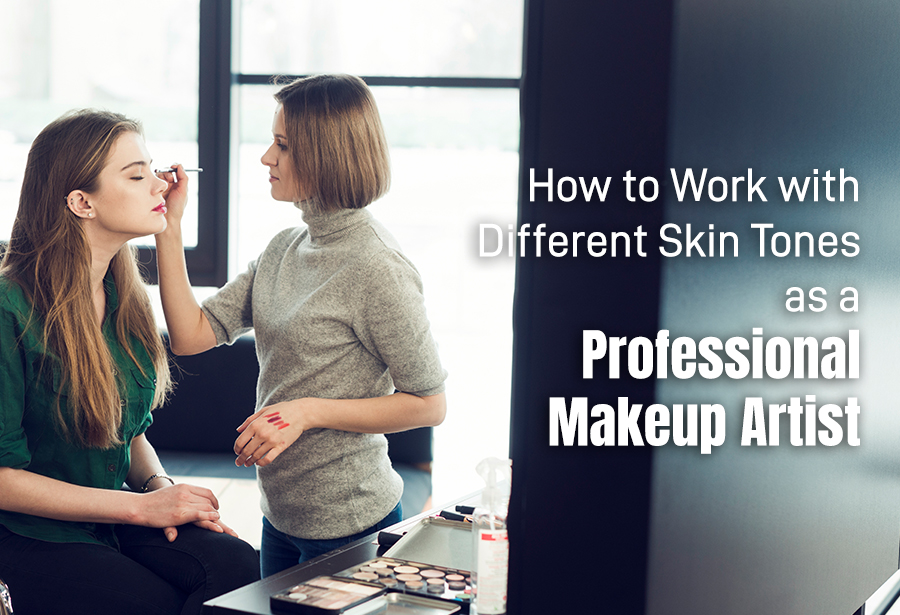
25 Sep How to Work with Different Skin Tones as a Professional Makeup Artist
As a makeup artist, one of the most important skills you can develop is the ability to work with different skin tones. Every client’s skin is unique, and understanding how to enhance their natural beauty while complementing their individual complexion is essential to creating stunning, personalized looks. Whether you’re working with fair, medium, olive, or deep skin tones, this guide will provide you with the knowledge and techniques you need to master the art of makeup for all skin tones.
-
Understanding Undertones
The key to working with different skin tones lies in understanding undertones. Undertones are the subtle hues that lie beneath the surface of the skin and affect its overall shade. There are three main types of undertones:
– Cool Undertones: Skin with cool undertones has hints of blue, pink, or purple. People with cool undertones often have fair skin that burns easily, though cool undertones can also be present in deeper skin tones.
– Warm Undertones: Warm undertones have hints of yellow, gold, or peach. This undertone is common in medium to deep skin tones and gives the skin a sun-kissed appearance.
– Neutral Undertones: Neutral undertones are a balance of cool and warm tones. People with neutral undertones can often wear a wide range of colors and look good in both gold and silver jewelry.
To determine a client’s undertone, observe the veins on their wrist. If the veins appear blue or purple, the client likely has cool undertones. If they appear green, they have warm undertones. If it’s difficult to tell, they may have neutral undertones.
-
Choosing the Right Foundation
Selecting the right foundation is crucial for creating a flawless base that matches your client’s skin tone. Here’s how to choose the perfect shade:
– Match to the Neck: The best way to find the right foundation shade is to match it to the skin on your client’s neck. The neck is less likely to be affected by sun exposure and will provide a more accurate representation of their natural skin tone.
– Test in Natural Light: Always test foundation shades in natural light to ensure the color is true. Artificial lighting can alter the appearance of the shade and lead to mismatched results.
– Adjust for Undertones: Choose a foundation with the correct undertone. For cool undertones, opt for a foundation with pink or blue undertones. For warm undertones, select shades with yellow or golden undertones. Neutral undertones work well with foundations that are balanced and neither too warm nor too cool.
– Mixing Shades: If you’re unable to find a perfect match, don’t hesitate to mix two shades to create a custom blend. This technique is especially useful for clients with unique skin tones that fall between standard shades.
-
Highlighting and Contouring for Different Skin Tones
Highlighting and contouring are essential techniques for adding dimension to the face and enhancing natural features. However, the shades you use should complement your client’s skin tone:
– Fair Skin: For fair skin, use a highlighter with a soft, pearlescent finish and a contour shade that is only slightly darker than the skin tone. Avoid using overly warm bronzers, as they can appear orange on lighter skin.
– Medium Skin: Medium skin tones can handle more warmth in both highlighter and contour shades. Opt for golden highlighters and bronzers with warm undertones. The contour shade should be a few shades darker than the foundation but still blend seamlessly into the skin.
– Olive Skin: Olive skin tones often have a natural warmth, so choose highlighters with a golden or champagne finish. For contouring, use shades with a slight ashiness to avoid adding too much warmth, which can make the skin appear sallow.
– Deep Skin: For deep skin tones, choose highlighters with a rich gold or bronze finish to create a radiant glow. Contouring should be done with deep, cool-toned browns that define without appearing too harsh.
Blending is key in highlighting and contouring. Make sure the products are well-blended to avoid harsh lines and create a natural, sculpted look.
-
Selecting the Perfect Blush and Bronzer
Blush and bronzer add warmth and color to the face, but it’s important to choose shades that complement the skin tone:
– Fair Skin: Light pinks, peaches, and soft corals work beautifully on fair skin. Avoid overly bright or dark shades that can look unnatural. For bronzer, choose a light, cool-toned brown to avoid an orange cast.
– Medium Skin: Medium skin tones can carry deeper shades of pink, coral, and berry. Bronzers with warm undertones add a healthy glow to the skin. Look for shades that enhance the natural warmth of the complexion.
– Olive Skin: Olive skin tones look stunning in earthy shades like terracotta, warm rose, and muted coral. Choose bronzers with golden or olive undertones to complement the skin’s natural warmth.
– Deep Skin: Deep skin tones can handle rich, bold colors like deep berry, brick red, and bright coral. For bronzer, opt for deep, warm browns that add depth and definition without looking ashy.
When applying blush and bronzer, start with a light hand and build up the color gradually. This allows for a more natural finish and prevents the makeup from looking too heavy.
-
Choosing Lip Colors for Different Skin Tones
Lip color is a powerful way to express personality and complete a makeup look. Here’s how to choose the perfect shades for different skin tones:
– Fair Skin: Soft pinks, nudes, and light corals are flattering on fair skin. For a bold look, try cool-toned reds or berry shades. Avoid shades that are too dark, as they can overwhelm lighter skin tones.
– Medium Skin: Medium skin tones can wear a wide range of colors, from peachy nudes to bright pinks and deep reds. Coral and warm-toned reds are especially flattering. Experiment with both bold and neutral shades to find the perfect match.
– Olive Skin: Olive skin tones look great in warm, earthy shades like terracotta, coral, and brick red. Deep berry and burgundy shades also work well for a more dramatic look. Nude lipsticks with a peachy undertone complement the natural warmth of the skin.
– Deep Skin: Deep skin tones can rock bold, vibrant colors like rich reds, deep plums, and bright oranges. Chocolatey browns and deep nudes are also stunning choices. Avoid lip colors with too much white in the base, as they can appear chalky.
When applying lip color, use a lip liner to define the shape and prevent feathering. For a long-lasting finish, apply the lipstick, blot with a tissue, and then apply a second layer.
-
Eyeshadow and Eyeliner Techniques
Eyeshadow and eyeliner choices can enhance the eyes and add depth to the overall makeup look. Here’s how to choose shades that work well with different skin tones:
– Fair Skin: Light, neutral tones like champagne, taupe, and soft pinks work beautifully on fair skin. For eyeliner, brown or gray shades offer definition without being too harsh. Avoid overly dark or bright colors that can overwhelm the eyes.
– Medium Skin: Medium skin tones can carry warmer eyeshadow shades like bronze, gold, and warm browns. Rich jewel tones like emerald and plum are also flattering. For eyeliner, both brown and black work well, depending on the desired intensity.
– Olive Skin: Olive skin tones look stunning in earthy eyeshadow shades like copper, olive green, and deep gold. Warm, smokey eyes with shades of brown and bronze enhance the natural warmth of the skin. Dark brown or black eyeliner adds definition and drama.
– Deep Skin: Deep skin tones can pull off bold, vibrant eyeshadow colors like deep purples, blues, and rich coppers. Metallic shades in gold and bronze create a stunning contrast. For eyeliner, black or deep brown offers a striking definition.
When applying eyeshadow, blend well to create a seamless transition between colors. For eyeliner, consider using a smudged pencil for a softer look or a precise liquid liner for a more defined finish.
Working with different skin tones requires an understanding of undertones, product selection, and the right application techniques. By mastering these skills, you can create beautiful, personalized looks for every client, enhancing their natural beauty while respecting their unique complexion. At Makeup Studio Training Centre, we provide comprehensive training that equips aspiring makeup artists with the knowledge and expertise needed to work confidently with all skin tones. Whether you’re just starting out or looking to refine your skills, our courses are designed to help you excel in the diverse and dynamic world of makeup artistry.
If you are looking for a professional makeup course in Delhi, Makeup Studio Training Centre is the best academy to learn makeup. Reach out to us today and kickstart your career in make up artistry!



Sorry, the comment form is closed at this time.